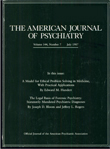TO THE EDITOR: The March 1997 article by John S. Lyons and associates (
1) recommended not using readmission as an indicator of quality of care. Their study advances our understanding of readmission but is based on three potentially controversial underlying assumptions and methods that merit further discussion.
First, the authors downplay the notion that excellent inpatient care can prevent readmission. The hospitals studied offer short-term psychiatric hospitalization with the “treatment goals of crisis stabilization rather than longer-term treatment of the psychiatric disorder.” The authors claim that once the hospital has arranged for a referral, “prevention of readmission is likely the responsibility of the community care provider.” They partially reinforce this model by demonstrating a lack of associations between index admission characteristics and readmission. If both providers and payers agree that treatment is not a goal, then the authors are correct to suggest that we abandon prevention of readmission as an indicator of high-quality care.
Second, the authors seem to support the notion that poor-quality inpatient service can make it harder for a client to live in the community. They found no association between readmission and length of stay and concluded that “the shortening of hospital stays.does not appear to result in a revolving door model of inpatient care.” This analysis demonstrates how readmission can be used as a quality indicator when it interprets lack of association as adequate program functioning.
Readmission is a direct measure of our goal of clients living in the community. Other measures, such as length of stay or clinical status at discharge, are indicators of the process for attaining this goal. We may overlook declines in quality if we follow Lyons and associates' recommendation to ignore readmission, since it is unlikely that a list of process indicators will always be complete and accurate. Considering that routine quality analyses are secondary analyses, the likelihood of unreliable data is especially high, and measuring direct client outcomes becomes even more important (
2).
Third, different analytic techniques may increase readmission's descriptive power. The authors used dichotomous models that assign all readmissions equal weight, but 40% (N=18 of 45) of their study group's readmissions occurred within the first 30 days of a 6-month follow-up. Statistical methods that incorporate person-time, such as Poisson distribution or proportional hazards regression, can indicate factors that cause faster readmission. For example, one factor causing readmission on day 5 of follow-up is clearly more harmful than another causing readmission on day 30. Assigning the outcomes equal weight could bias results toward the null.
Armed with more accurate tools, payers and providers should continue to use changes in adjusted readmission rates to make comparisons either of one facility over time or between facilities in a network.

